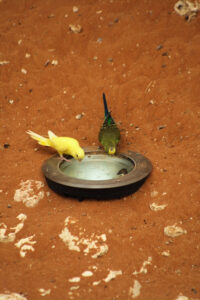Have you ever seen a black budgie or parakeet and wondered how it is possible?
Well, black face budgies indeed exist in this world. It is a new type of budgie found in 1970 in the Netherlands.
If black face budgies are real, then how can you get one? Who can breed a black budgie, and what are the mutations and circumstances you should know?
All of these concerns will be answered in today’s guide. All you have to do is stick with us till the end.
Can You Breed Black Budgies?
Well, there is no certain answer as to whether you can breed a black budgie.
However, specialist breeders can do that even with ease. But, for you, it might be difficult as you have to come up with lots of breeding information first.
For some, breeding black budgies might not be a big deal as they have been doing it for years. You only need to cross-breed between two to get a back budgie.
So, more controlled breeding experiments can result in the black mutation of these cute pet parakeets.
How Do You Breed An Anthracite Budgie?
Although, it’s possible to breed black or anthracite budgie. However, understanding the genetics, budgie colors, and body markings is all a must to get the best experience.
To get the best surety of a black budgie, you must visually distinguish between a male budgie and a female. For example, if both breeds have anthracite genes, getting a black budgie color mutation would be easier.
Conversely, this is not the single factor to consider.
There is a lot more that you should also know before becoming ready to breed this unique color budgie.
Here is a simple guide for it.

Step 1: Choose the right genes:
First and foremost, the possibility and the chances of successful breeding start with choosing the right genes to dominate the color mutation.
In this regard, you must choose both pairs of birds that are from anthracite genes. On the contrary, you can also go for the budgies already anthracite.
You can also get the gene test to determine the dark anthracite budgie. However, it’s generally costly.
Step 2: Create a breeding environment:
After selecting the genes, your next step is to provide the pair with a perfect breeding environment.
You must provide a safe space and plenty of toys, fruits, vegetables, perches, and other things to eat.
Remember, the pellet must be a quality mix and not be ordinary.
Step 3: Pair the Birds
Your third step to creating this rare black mutation is to make a pair of birds.
While pairing, you must ensure that both male and female parrots are compatible with each other and their temperature belongs specifically.
For example, both breeds must not be aggressive to each other.
This will also help you to ensure a smoother breeding experience.
Step 4: Start incubating the eggs
The real process starts when birds have mated and the female lays the eggs.
At this stage, you only need to place them where they can. However, you must know it could generally take up to 18 days.
So, don’t rush the process.
Step 5: Raise the cheeks
It’s time to raise the cheeks, whether male or female; you will get the estimate of a new mutation.
At this stage, you must ensure to provide them plenty of food, water, warmth, and comfort they need.
Step 5: Analyze the results
Once they grow up, it’s time to check the coloration.
Remember, the budgerigar mutation doesn’t reveal until they reach maturity or adulthood.
As a result, this is how you can also get this rare mutation, budgie.
Are Black Wing Budgies Rare?
Yes, one of the rare budgies has black wings.
It’s not because of its rare color but gene mutation and selective breeding. For example, it is often said that to get a black wing budgie, you must breed between the two male and female budgies, whereas in between, one must have black markings on its wings.
However, the general rule of thumb and the easiest way is to breed the two blackwing birds to get the one.
Additionally, they have black markings because of the excessive melanin pigments resulting in the black marking on wings.
Are Blackface Budgies Rare?
Do you know one of the first blackface budgies was bred in the Netherlands ’90s? After that, it’s often said that nobody can breed blackface budgies.
So, yes, blackface budgies are rare. Even we can say it’s hard to find one, especially if you are trying outside the Netherlands.
A person from the Netherlands bred two bluebirds that had unusual markings on their body. And at that time, it resulted in blackface budgie. It means a dark-colored parakeet and a blue bird can result in a new mutation, which will be blackface budgies.
Although they are rare, as they have been bred before, it’s not impossible, and getting them is relatively easy.
FAQ:
Can you get a black budgie?
Yes, you can get a black budgie. In fact, the more you read about this cute budgie, you will get to know that they are the cutest, playful, and friendly birds. They also have a unique personality. And for these reasons, this is the most common pet after dogs and cats.
What is the price of black budgie?
Generally, you can get a black budgie for 10 to 50 dollars. However, it’s just an estimate where several other factors also affect the pricing. For example, the demand, rarity, and breeding cost.
Do black budgies exist?
Black budgies do exist. Commonly, they are known as anthracite or blackface budgies. Furthermore, they are known as the little, cute, unique color budgie bred by the breeders. That’s why it also has several color mutations as well.
